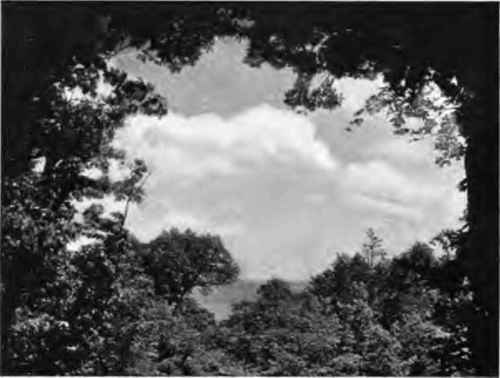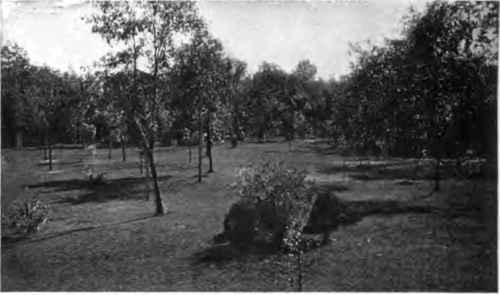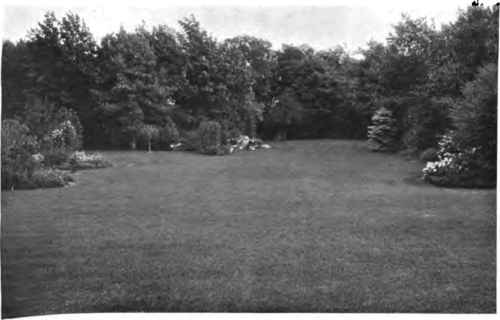How I Built My Country Home. A Concrete Example Of Landscape Gardening. Continued
Description
This section is from the book "How To Make A Flower Garden", by Wilhelm Miller. Also available from Amazon: The Well-Tended Perennial Garden: Planting and Pruning Techniques.
How I Built My Country Home. A Concrete Example Of Landscape Gardening. Continued
In my later plantings I had combined the hardy perennials with the shrubs, planting the former in masses, and not repeating the same perennial at any one point of view. Each shrubbery bed is so planted that some part of it is in bloom from early spring until frost.
The wooded ravines have been left to Nature's care. Wandering up and down the bank is prohibited except where walks are provided, as the denizens of the wood resent too much familiarity. I found ferns, trilliums, hepaticas or a few moccasin flowers in my own woods, and more from the neighbouring ravines have been added, until groups and colonies abound.

Side yard in 1902, looking toward the bouse.

A view of the lake caused the selection of the site.
These native plants thrill the heart with delight when spring's first breath rouses them to activity.
Along the shrubbery bank bordering the roadway to the stable, masses of squills, snow-drops, crocuses, chionodoxas, grape hyacinths, and narcissi herald a season of delight, while above them follow, in bloom, the shad-bush, the May-Day tree, and flowering plums and cherries, and the Missouri currant mingles its spicy breath with the scent of the freshly turned soil, just aroused from its frozen slumber. All these are but the advance-guard of a countless throng of hardy flowers that will open up in well-regulated succession, until the stately Anemone Japonica comes to fight its battle with Jack Frost.
My garden is open to all who will love and appreciate its contents, be they from the mansion in the park or from the cottager's home. My flowers bloom not for me alone, but for those of kindred tastes, and it is a pleasure for me to show them. Many delightful friends have thus been made.
The pleasures of gardening are infinite and varied. One need not delve in the mysteries of botanical lore in order to obtain enjoyment in one's intimacy with plant life. It is best to look upon plants as garden friends. The hardy forms become in time old-established companions, for each spring they arise from their slumber and greet you with renewed life. They are like some dear friends returned from a distant journey, whose presence we have missed.
Not the least of garden pleasures is the exchange of surplus plants with those of kindred tastes. I have many such cherished plants, some of which are from friends whom I have never seen. They are pleasant reminders of their donors, and, under more constant observation than a photograph hidden in an album, they fade not, neither do their gowns go out of fashion. It will pay the intending planter to give careful attention to companion cropping with ornamental subjects, so that there will be a successful effect on the same area, or that the defects of one plant may be remedied or covered by the excellences of another. Such a case is pictured on page 30. Here are Lilium superbum and peonies. The peony is the earlier riser, starting sooner into growth, and maturing its flowers before the lily has shot its blooming spike above the surrounding foliage. The lily is thus unseen at this time, and takes no part in the floral display; but soon after the withered peony blooms have been cleared away the tall lily spikes emerge from the mass of dark-green foliage, and, rising high above it, form their candelabra heads of coral-tinted bells. There is economy in this method, as two crops of bloom, each differing entirely from the other, are produced from one bed.
An allied lily, L. Canadense, found on the drier parts of the meadow, is another that takes most kindly to garden life. I use it also as a second-crop flower, and to give height and variety to the border.

The side yard in 1890.Worthless trees scattered here and there. No view.

The same side yard ten years later, showing how a picture was made by cutting out trees that were in the way.
I grow the American cowslip, or shooting star, which loses its foliage soon after blooming in the spring. Alternating with the plants are Cam-panula Carpatica, whose spreading foliage carpets the ground left bare by the disappearing dodecatheons. Here and there in among both these plants are placed the Canadian lilies, producing a pleasing combination. Both of these lilies may be gathered from our prairies when in bloom, cutting their stalks back to within a foot of the ground, and keeping the bulbs damp while exposed, planting them where wanted at once or in temporary quarters until the fall months.
There are many beautiful flowering bulbs and plants that we should all grow whose foliage ripens off and disappears soon after blooming. They are generally of a character requiring planting in masses to be effective, and are early to flower and vanish, leaving generous spaces of vacant ground until the next spring, adorned only by a monument in the shape of the identifying label. This label is essential in large plantings, for without it the presence of dormant bulbs might be overlooked and damage done in careless digging. How to cover these bare spaces is a matter of importance to those who desire their borders to look neat and tidy. I plant snowdrops, chionodoxas, scillas, crocus, grape hyacinths, and all of the spring-blooming class, in masses under widespreading shrubs, so situated that the sun will reach them during part of the day.
My physician's prescription should be incorporated in the materia medica of all nations. It was extremely pleasant to take, and not only restored my shattered health, but was the means of awakening in me a love for the greatest of all delights - one's own garden.
Continue to:


